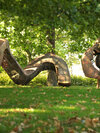Art & Culture
Artists and artistsWalter Schelenz
* May 21, 1903 in Karlsruhe; † September 5, 1987 in Freiburg im Breisgau; German sculptor
Walter Schelenz attended the Badische Landeskunstschule from 1922 to 1923. He studied at the Academy of Fine Arts in Dresden from 1923 to 1927, where he became a master student of Karl Albiker. From 1927 to 1940, he lived as a freelance sculptor in Berlin and later in Neubabelsberg. During the Second World War, he was assigned to an air force staff in Russia as a technical draughtsman from 1940 to 1945. After the end of the war, Walter Schelenz lived in Menzenschwand in the Black Forest. In 1947, he founded the Bonndorf Castle School of Arts and Crafts. From 1954 to 1961, he headed the Berufsverband Bildender Künstler (BBK) Südbaden. From 1955, Schelenz lived and worked in Freiburg until his death. He was awarded the Upper Rhine Art Prize in 1959 and the Reinhold Schneider Prize of the City of Freiburg in 1970. In 1973, Schelenz was a guest of honor at the Villa Massimo Academy in Rome. In 1977, he was awarded the title of professor by the Minister President of the state of Baden-Württemberg.
from: "Skulptur in Freiburg, Kundst des 20. Jahrhunderts im öffentlichen Raum;
Published by Michael Klant in collaboration with Oliver Dieskau,
mondo verlag GmbH, Freiburg im Breisgau; ISBN 3-922675-76-X
Between tradition and modernity
Many artists who were influenced by the academic tradition of idealizing figuration remained committed to it until the end of the Second World War, despite being compromised by the National Socialist conception of art. After 1945, however, they were confronted with the generally binding demands of non-representational art.
The sculptor Walter Schelenz is an example of an artist who was challenged to reorient himself in this way. Based on an extensively documented catalog of works, this study focuses primarily on the period after 1945, concentrating on the problems of a traditionally trained sculptor who found himself confronted with the modernism of the 20th century and examining his specific approach to the new content and form on offer.
After a biographical overview, the artist's stylistic development and repertoire of forms are therefore presented, in particular his sculptures created for public spaces; his receptive engagement with artistic trends before and after 1945 and the resulting consequences for the sculptor's self-image and concerns are also analyzed.
The delayed and largely form-oriented engagement with the achievements of the avant-garde in the work of the sculptor Walter Schelenz after 1950 can be seen as representative of related artists of his generation. The constantly endangered balance between form and content, which was only achieved at a late stage and which can be observed not only in Schelenz's work, but in the work of many of these artists, can probably be traced back to the massive questioning or vehement rejection of their idealizing image of man after 1945/50.
For this reason, Schelenz's achievement lies essentially in his late work, which refuses any opportune topicality and, after years of abstract experimentation, finds its way back to a fundamentally changed, haunting figurativeness in small, lively spatial formations.
from: Between tradition and modernity: The sculptor Walter Schelenz (1903-1987) by Sabine Fischer;
scaneg Verlag; ISBN 978-3-89235-041-5
wikipedia de.wikipedia.org/wiki/Walter_Schelenz
University Medical Center Freiburg
Hugstetter Straße 55
79106 Freiburg
Phone: 0761 270-0
info@uniklinik-freiburg.de




